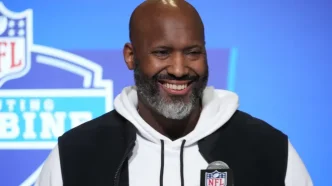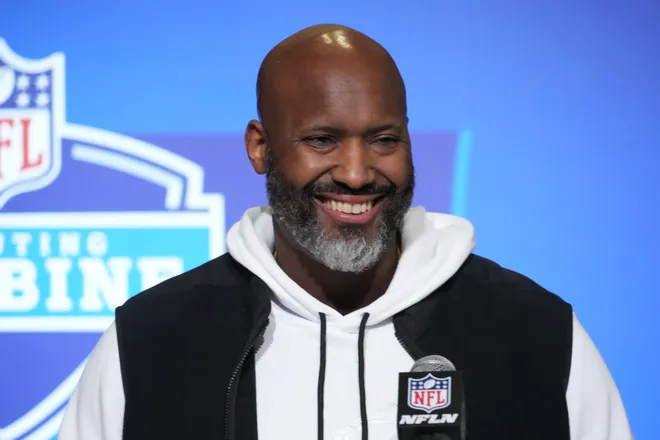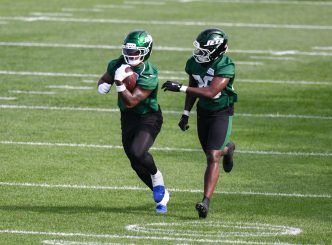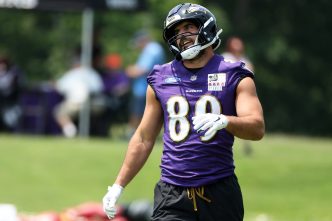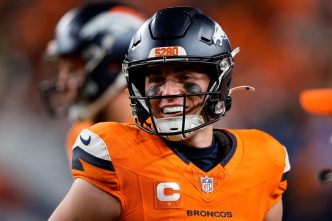In the latest chapter of NFL Draft intrigue, the Detroit Lions made waves during the third round of the 2025 NFL Draft, as general manager Brad Holmes orchestrated a bold move to grab the attention of fans and analysts alike. By vaulting from pick 102 to 70 in a trade with the Jacksonville Jaguars, Holmes demonstrated his commitment to shaking things up, targeting wide receiver Isaac TeSlaa, a selection that raised a mix of eyebrows and curiosity around the league.
In a conversation on Tuesday with the Costa and Jansen show on 97.1 The Ticket in Detroit, Holmes openly discussed his draft picks, revealing an enthusiastic fondness for TeSlaa. “I do love all of them,” he said, but he gave TeSlaa a special mention, admitting, “The pick that was probably the most questioned… was Isaac TeSlaa. I can say that he was my favorite wide receiver in this draft.” While he stopped short of labeling him the best, it’s clear there’s something he sees in TeSlaa that caught his eye—and the interest of fans.
The hefty trade cost—sending the 2025 third-round pick (102) along with two future third-round selections in 2026—led to considerable chatter about whether this was a shrewd investment or a risky play. The Lions not only acquired TeSlaa but also received a sixth-round pick in both 2025 and 2026 from the Jaguars. This kind of aggressive maneuver in the draft can spark debates, especially when other teams often hesitate to dip into future capital for immediate gains.
On Day 2 of the draft, Holmes and his team donned black sweatshirts emblazoned with “H.W.S.” crossed out—a clever nod to their philosophy that game film outweighs raw physical measurements. This raises an interesting point, especially with TeSlaa, who had been highlighted as one of the most athletic prospects available. Standing tall at 6-foot-4 and weighing 214 pounds, TeSlaa notched an impressive 96 in his Athleticism score at the 2025 NFL Scouting Combine, the highest among wide receivers. However, despite his athletic prowess, his production—62 catches for 897 yards over two years at Arkansas after transferring from Hillsdale College—opens the door to questions about his readiness to take on a significant role in a professional offense.
Holmes has hinted that he moved up the board with TeSlaa in mind, noting that he was ranked among the top players remaining, regardless of position. His insight into the selection process shines through as he reflects on the draft’s evolving landscape. “Not all drafts are the same,” Holmes noted, pointing out that depth can vary significantly from year to year. He emphasized that the Lions were at a juncture where the third-round options weren’t yielding the same caliber of talent as in past drafts. Looking back, he remarked that players like Alim McNeill and Amon-Ra St. Brown—both of whom have become pivotal for the Lions—remain elusive prospects for teams picking later in drafts.
Holmes’ deft juggling act of transforming the Lions from a team that many overlooked into a legitimate contender has earned him the benefit of the doubt among fans and analysts. Yet, the risk of trading future picks in pursuit of immediate impact players is a gamble many general managers face. The conversation surrounding the Lions’ decision will undoubtedly continue, as the real measure of success for TeSlaa’s selection won’t be apparent for at least a year or two.
If TeSlaa manages to evolve into a formidable target, particularly in the slot, the Lions’ bold decision could pay off handsomely, rendering the loss of those future third-round picks inconsequential in the broader scope of success. However, if he falls short and fails to make a significant impact, the trade may become a point of scrutiny. Such are the unpredictable dynamics of the NFL Draft, where every decision is a stepping stone to building a championship team. The coming season will be a pivotal proving ground for both TeSlaa and the Lions’ strategy, with all eyes keenly focused on the outcome.

